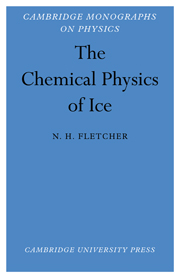Book contents
- Frontmatter
- Contents
- Preface
- Note on Units
- CHAPTER 1 The water molecule
- CHAPTER 2 Structure and energy of ordinary ice
- CHAPTER 3 Other forms of ice
- CHAPTER 4 Liquid water and freezing
- CHAPTER 5 Crystal growth
- CHAPTER 6 Thermal properties and lattice dynamics
- CHAPTER 7 Point defects
- CHAPTER 8 Mechanical properties
- CHAPTER 9 Electrical properties
- References
- Subject Index
CHAPTER 1 - The water molecule
Published online by Cambridge University Press: 21 May 2010
- Frontmatter
- Contents
- Preface
- Note on Units
- CHAPTER 1 The water molecule
- CHAPTER 2 Structure and energy of ordinary ice
- CHAPTER 3 Other forms of ice
- CHAPTER 4 Liquid water and freezing
- CHAPTER 5 Crystal growth
- CHAPTER 6 Thermal properties and lattice dynamics
- CHAPTER 7 Point defects
- CHAPTER 8 Mechanical properties
- CHAPTER 9 Electrical properties
- References
- Subject Index
Summary
To gain a proper understanding of the behaviour of a complex system we must first appreciate the structure and properties of the elementary units of which it is composed. In the study of ice this means that we must begin with a study of the water molecule, for it is from the individuality of the structure of that molecule that most of the unusual properties of ice and water arise. Without such a relation back to the fundamentals of molecular structure, the study of a particular material becomes simply a catalogue of its properties—useful, no doubt, but not very illuminating. In this book we shall try, at all stages, to show this relation so that a coherent picture emerges. Similar pictures can be built up for all solids; the outlines, it is true, have many variations but they all follow in the same sort of way from the basic elements of which they are built.
Water is among the simplest of molecules and for that reason if no other it has been the subject of a large amount of theoretical work, computation and experiment. Molecular structure is not a simple subject, however, and our understanding is still far from complete, but it is enough to give a picture of the water molecule which is reasonably accurate and sufficient for our present purposes.
- Type
- Chapter
- Information
- The Chemical Physics of Ice , pp. 1 - 22Publisher: Cambridge University PressPrint publication year: 1970



